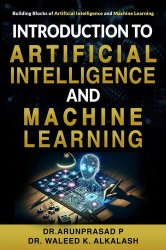Introduction to Artificial Intelligence And Machine Learning
- Добавил: literator
- Дата: 6-05-2025, 21:15
- Комментариев: 0
 Название: Introduction to Artificial Intelligence And Machine Learning: Building Blocks of Artificial Intelligence and Machine Learning
Название: Introduction to Artificial Intelligence And Machine Learning: Building Blocks of Artificial Intelligence and Machine LearningАвтор: Arunprasad P, Waleed K. Alkalash
Издательство: Guided Self Publishing (I) LLP
Год: October 26, 2024
Страниц: 430
Язык: английский
Формат: pdf, epub (true)
Размер: 10.1 MB
"Introduction to Artificial Intelligence & Machine Learning" provides a comprehensive foundation for AI and ML concepts. It covers AI history, types, benefits, risks, and applications across various industries. The book explores Machine Learning, Deep Learning, neural networks, and practical AI problem-solving approaches. It also introduces Python programming, discussing variables, control statements, functions, and data structures essential for AI and ML development. With theoretical insights and practical examples, the book aims to equip students, researchers, and professionals with the knowledge needed to apply AI and ML techniques effectively in real-world scenarios.
Artificial Intelligence (AI) refers to the simulation of human intelligence processes by machines, particularly computer systems. These processes include learning (the acquisition of information and rules for using the information), reasoning (using rules to reach approximate or definite conclusions), and self-correction. AI systems are designed to perceive their environment, process data, and take actions to achieve specific goals, mimicking cognitive functions such as problem-solving and decision-making that are typically associated with human minds. AI encompasses a broad spectrum of technologies, including Machine Learning (ML), natural language processing (NLP), robotics, computer vision, and expert systems. While machine learning focuses on enabling systems to learn and improve from experience, NLP allows machines to understand, interpret, and respond to human languages. Robotics integrates AI with mechanical devices to perform complex tasks, and computer vision helps systems interpret and process visual information. Expert systems replicate decision-making abilities in specific domains by using databases of knowledge and inference rules. The field of AI can be categorized into narrow AI and general AI. Narrow AI, also known as weak AI, is designed to perform specific tasks, such as voice recognition, recommendation systems, or autonomous driving. These systems excel in their designated areas but lack generalization across multiple domains. On the other hand, general AI (or strong AI) aims to build machines that possess the ability to perform any intellectual task that a human can, demonstrating understanding, reasoning, and learning across diverse situations.
Python supports multiple programming paradigms, including procedural, object-oriented, and functional programming, offering flexibility for a wide range of applications. One of Python's most notable features is its extensive standard library, which provides pre-built modules and functions for handling tasks like file I/O, string manipulation, mathematics, and more. This reduces the need for writing complex code from scratch, enabling developers to focus on solving problems rather than reinventing the wheel. Python's dynamic typing and automatic memory management further simplify development, making it easier to prototype and iterate. Python is widely used across various domains such as web development, data science, artificial intelligence, machine learning, automation, and scientific computing. Frameworks like Django and Flask make it a popular choice for web development, while libraries such as NumPy, Pandas, and TensorFlow empower data scientists and AI researchers to work efficiently. Additionally, Python's cross-platform compatibility ensures that programs written in Python can run seamlessly on different operating systems like Windows, macOS, and Linux. The language's growing community and active development ensure that Python remains a top choice for both academic research and industrial applications. Its open-source nature allows developers worldwide to contribute to its growth, ensuring continuous improvement and a wealth of resources. Python's simplicity, versatility, and robust ecosystem make it a cornerstone of modern programming.
Скачать Introduction to Artificial Intelligence And Machine Learning
Внимание
Уважаемый посетитель, Вы зашли на сайт как незарегистрированный пользователь.
Мы рекомендуем Вам зарегистрироваться либо войти на сайт под своим именем.
Уважаемый посетитель, Вы зашли на сайт как незарегистрированный пользователь.
Мы рекомендуем Вам зарегистрироваться либо войти на сайт под своим именем.
Информация
Посетители, находящиеся в группе Гости, не могут оставлять комментарии к данной публикации.
Посетители, находящиеся в группе Гости, не могут оставлять комментарии к данной публикации.
